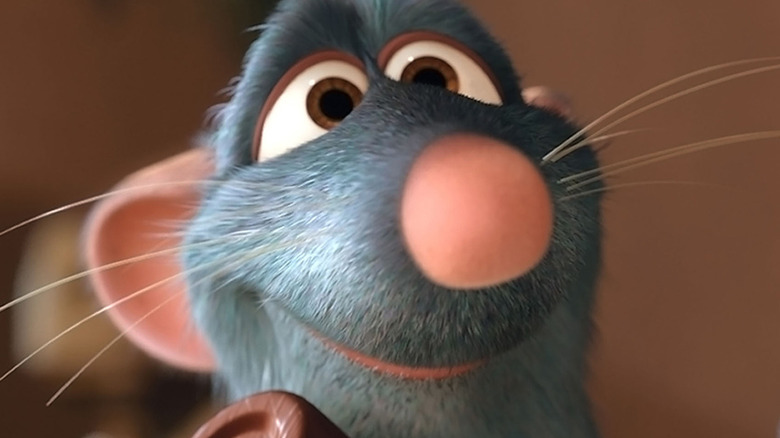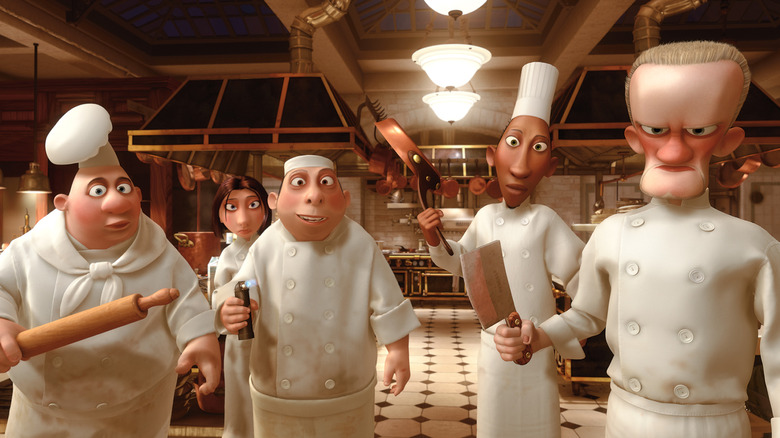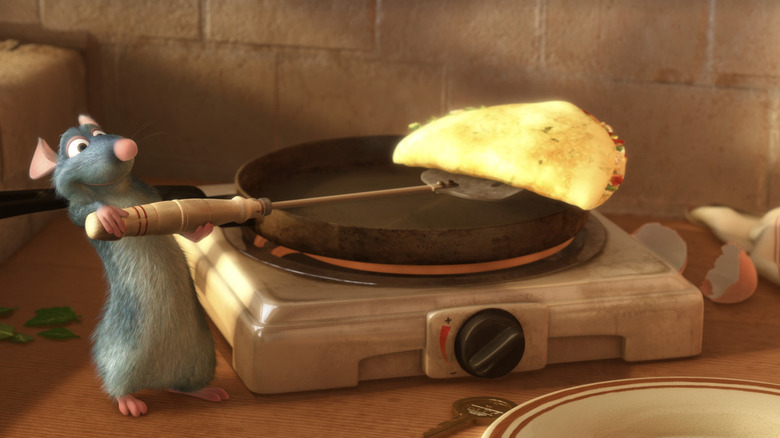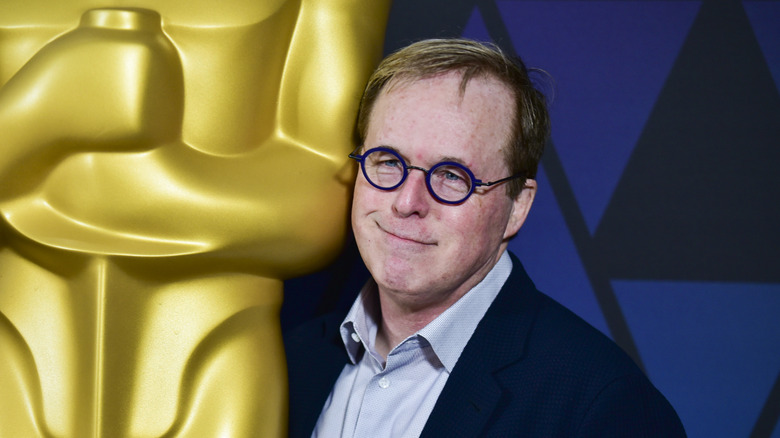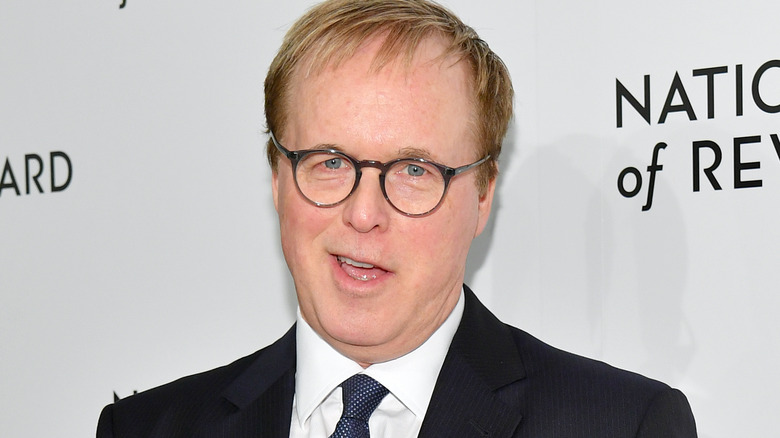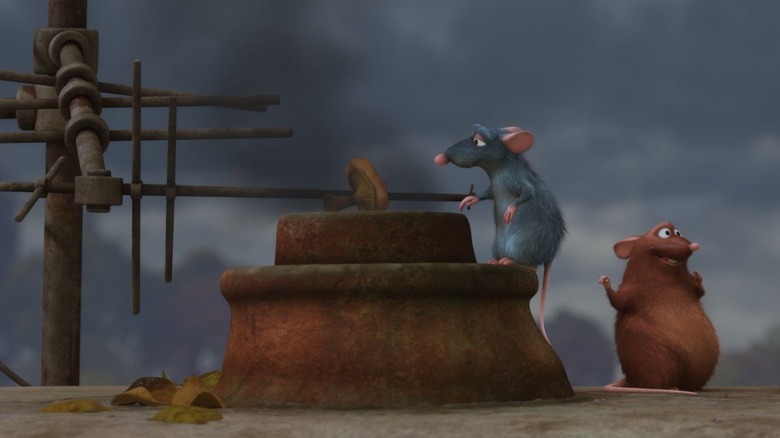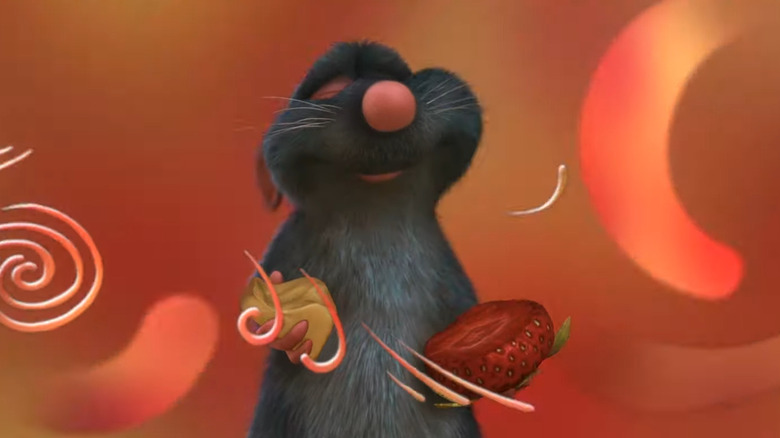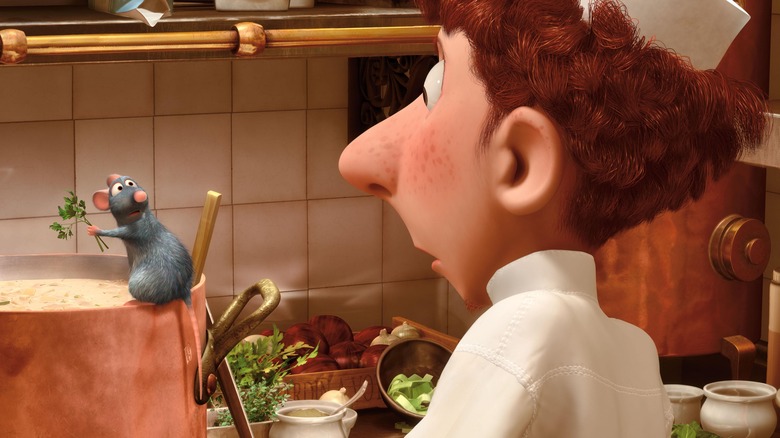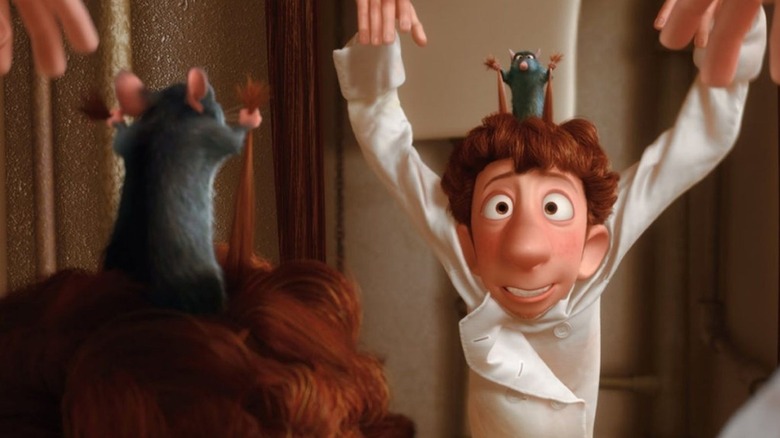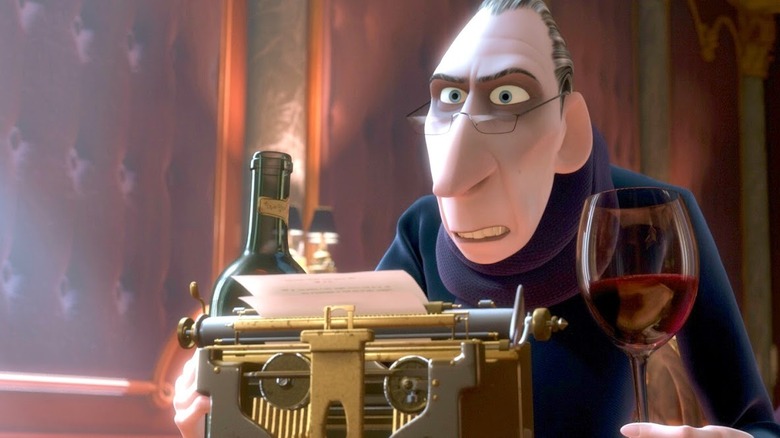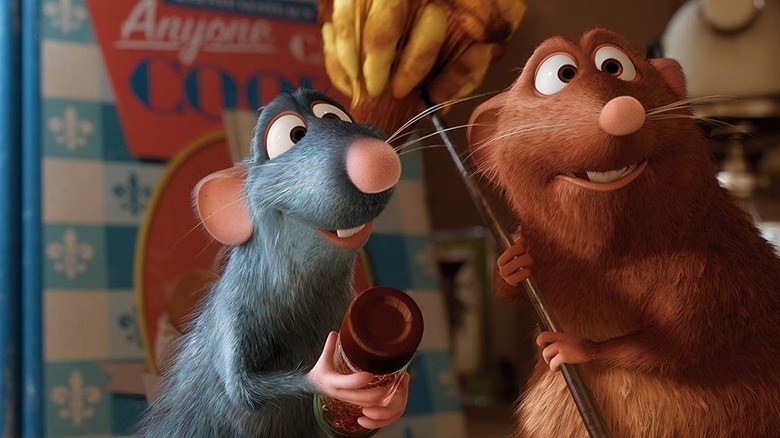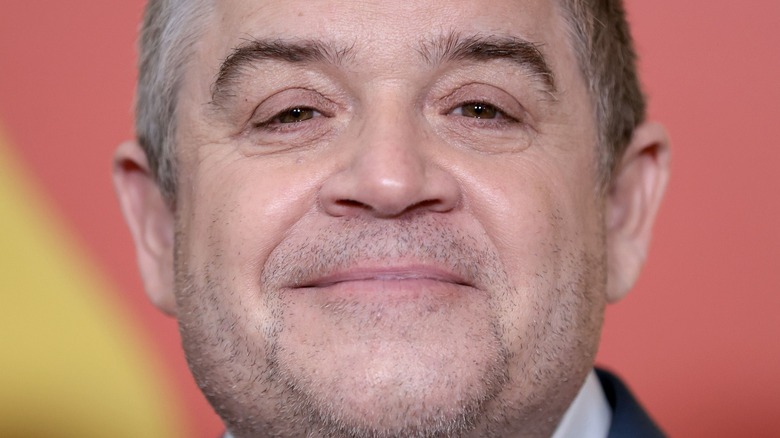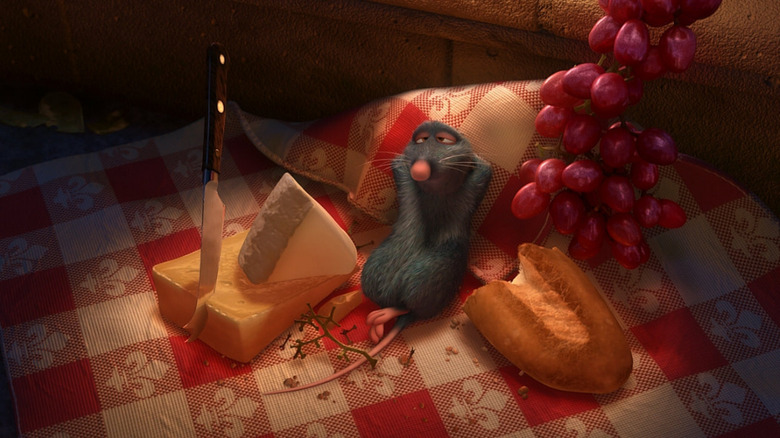The Untold Truth Of Ratatouille
What a strange movie "Ratatouille" is — what a beautifully strange movie. Armed with an utterly singular premise about a rat who learns how to cook in a gourmet kitchen in Paris, it's the kind of film that could easily get lost chasing its own strange proclivities. Instead, writer/director Brad Bird delivered something that turned a peculiar scenario into a plot you could get dramatically invested in. Even better, he did so while delivering lots of laughs and memorable animation. The countless artistic feats of "Ratatouille," not to mention its incredibly distinctive plot, have ensured that it's endured in pop culture since its June 2007 premiere. The recurring references to it in the indie hit "Everything Everywhere All at Once" serve as only one of the most recent examples of "Ratatouille" continuing to reverberate throughout the world.
But even with the ubiquity of "Ratatouille," not every aspect of this Oscar-winning feature has become common knowledge among the general public. The behind-the-scenes tale of "Ratatouille" is one full of creative detours, specific and groundbreaking visions for the film's visuals, and even issues Disney had in promoting such an unorthodox title. Though it may have seemed like an exercise in gratuitous weirdness when it was first announced, the untold truth of "Ratatouille" reflects all the care and compassion that went into crafting an irresistible treat of a movie.
The original director of Ratatouille
Long before "Ratatouille" hit theaters, the film was the brainchild of Jan Pinkava. The name may not be immediately recognizable to everybody, but Pinkava has a remarkable legacy at Pixar Animation Studios. Director of the short film "Geri's Game," Pinkava pushed the company's computer-animation technology to new places by centering one of these shorts on a human being. To boot, the short scored an Oscar win for best short film, lending extra prestige to Pixar's reputation as a company. After such glory, it was only a matter of time before Pinkava graduated to more elaborate directorial assignments at the studio.
This is where "Ratatouille" came into the picture, with Pinkava explaining to Animated Views that he was initially working on a wholly separate idea for his directorial debut that eventually fell apart. With this concept dead in the water, it was time for something new. Pinkava would eventually pitch three different ideas to the brass at Pixar for his first directorial assignment. The one that got the biggest response by far was his initial concept of a rat who wants to work in a kitchen. From there, Pinkava was off to the races, with "Ratatouille" getting the greenlight. Though he wouldn't stay around as its director through the entirety of the production, Pinkava's initiative in coming up with "Ratatouille" in the first place makes him an indispensable part of the film's legacy.
Why Ratatouille lost its original director
The history of Pixar movies is rife with directors getting replaced during production, to varying degrees of effectiveness. One of the more controversial instances of this came when Brenda Chapman was let go from her passion project "Brave," with the final film scoring strong box office returns but weaker reviews than many other Pixar films. Meanwhile, the worst-reviewed Pixar title by a significant margin, "Cars 2," saw original director Brad Lewis being demoted to co-director during production, with original "Cars" director John Lasseter joining the project. A more positive version of this scenario came with Brad Bird taking over "Ratatouille" from Jan Pinkava, though the process was still no less painful.
While specific details on what led to Pinkava getting let go from "Ratatouille" have rarely been discussed publicly, the book "The Pixar Touch" by Michael Price does offer some insight into what went down here. Allegedly, Pixar brass were concerned about the state of "Ratatouille" and initially hired Pixar veteran Bob Peterson to oversee the film's script and help get it back into shape. When that didn't solve all the concerns, Pinkava was let go and Bird, fresh off his Oscar-winning work on "The Incredibles," was brought in to get the movie to the finish line. It's never ideal for a director to get thrown off a movie they originated, but the history of Pixar shows there are way worse outcomes to this scenario than what happened during the production of "Ratatouille."
Why Brad Bird directed Ratatouille
While Brad Bird's first Pixar movie, "The Incredibles," was a personal passion project that he nurtured for years, "Ratatouille" was a movie he hopped onto while it was already well into production. With Jan Pinkava off the project and "Ratatouille" already set for a June 2007 release, the pressure was on for Pixar to get the project ready anyway. This is where Bird came in to the picture, with the filmmaker explaining to Animation World Network that he was off on vacation after just finishing "The Incredibles" when Pixar gave him a call to come aboard and help steer the "Ratatouille" ship.
Talking to Animation Arts Conservation years after "Ratatouille's" release, Bird admitted that he was understandably daunted by the concept of directing a movie he hadn't originated. He also said that he hated the idea of taking over another director's passion project but that he quickly opted to hop right back into doing another animated feature for the studio. This all came down to Bird's respect for Pixar. He admired the artists at this outfit deeply and also recognized that they were all in a pickle with a movie that needed to come out in 2007 but wasn't shaping up well. Considering that, Bird "took one for the team" in hopping onto "Ratatouille" and getting it into shipshape.
Brad Bird's experience taking over another director's movie
Brad Bird's faced a lot of challenges in his directorial career. How would he make a movie as tonally complicated as "The Incredibles?" How would he transition into live-action filmmaking with "Mission: Impossible – Ghost Protocol?" How would he manage to deliver on fan expectations with "Incredibles 2?" There's always extremely overwhelming circumstances working against you in making any feature-length movie, and the works of Bird have been no exception. On "Ratatouille," Bird had a special challenge in the form of taking over a movie that'd been the brainchild of filmmaking Jan Pinkava. How was Bird going to walk into Pinkava's passion project and make it work for his own sensibilities?
Talking to Entertainment Weekly, Bird noted that the biggest challenge in directing a movie that was already deep into production was the condensed schedule of the film. With "Ratatouille" already set for a June 2007 release and Bird entering the project at the start of 2005, the filmmaker had to work with a rapid schedule that was more "like a film-school project" than a traditional big-screen animated movie. He also noted that the quick schedule had its benefits, including forcing Bird to go with his gut rather than endlessly ruminate on creative decisions. Though far from ideal circumstances to make a movie in, Brad Bird threw himself into the challenges of directing "Ratatouille" just as he had on all the challenges of his other efforts.
The challenges in creating exquisite food
If "Ratatouille" was going to even remotely work, the film's animation team would need to bring its A-game in realizing mouth-watering food. "Ratatouille's" plot relied so heavily on Remy's fascination with all things culinary that if the various meats, cheeses, and vegetables didn't look quite right, the whole movie was going to crumble. Brad Bird was well-aware of this hurdle and, while promoting "Ratatouille," went to great lengths to emphasize all the advancements in animation that had been conjured up to ensure that on-screen food looked as delectable as possible.
Speaking to IGN, one particularly impressive animation feat that Bird highlighted was how "Ratatouille" reconstituted technology previously used to make human skin and faces look believable. Now, such tools were being employed to make the surfaces and textures of various food items look scrumptious. Bird especially appreciated how such advancements allowed for light to interact with certain dishes even more realistically. This same level of detail was even utilized for on-screen food that was supposed to look unappetizing, with such items looking even more repellant thanks to these animation techniques. The world of food is vast and heavily detailed, and "Ratatouille's" animation team stepped up to the plate to properly recognize all those intricacies.
Why Bird saw Ratatouille as being perfect for animation
In a modern world dominated by projects like the "Lion King" remake, it can be frustrating for animation devotees to see how often the medium is used for realism meant to emulate everyday reality. The beauty of animation comes from realizing imagery, characters, locations, stories, and so much more that could never be accomplished in reality. "Ratatouille," from the ground up, is a perfect example of something that could only be told in animation. It's that appropriateness for the artform and all its stylized possibilities that made Bird so passionate about "Ratatouille."
Talking to IGN before the film's release, Bird noted that the high-concept notion of a rat and a human working together in a Parisian kitchen was a difficult sell for many people. However, the screenplay for "Ratatouille" leaned into this and other absurd notions of the premise, with Bird insisting that the story not leap past any moments where it might seem like the premise would break from being too strange. Such bold narrative moves were made in the service of trying to make "the unbelievable believable and buyable." With that phrase, Bird may as well have been talking about the ultimate purpose of animation as a storytelling medium.
The crucial research trip to Paris, France
"Ratatouille" doesn't just take place anywhere — it's a story firmly rooted in the heart of Paris, France. Much like how the real-world Route 66 influenced the plot of "Cars" or how Mexican culture was intertwined with the soul of "Coco," France was a central part of "Ratatouille's" creative heart. Understanding this importance, the team behind "Ratatouille" made sure to travel over to this real-world location to gather vital research for the film. It's common for the crews of animated Disney movies to visit locations their features will be depicting, and the importance of such voyages was underscored by "Ratatouille."
Talking to Collider, Bird noted that he only went on one of the multiple voyages that the "Ratatouille" story and art team took to Paris. Even in his solitary visit, though, Bird caught lots of subtle details about this iconic city. The most explicit source of inspiration that Bird received in his trip was walking along the Seine, which informed the backdrop of the crucial moment in "Ratatouille" where Remy and Linguini form a pact to work together. While also noting that the group wanted to give more of an "impression" of Paris rather than a 100% accurate vision of the city, Bird also reveled in all the real-life wonders that this locale offered.
The inspirations for Ratatouille's character designs
The character designs of "Ratatouille" had a lot riding on their shoulders. For one thing, this aspect of the production had to make rats that wouldn't immediately turn off the viewer without also lapsing into cutesy caricature. For another, this film also had to make sure the human characters looked just right, a notable obstacle since this was only the second Pixar movie (following "The Incredibles") to feature a largely human cast. These were challenging difficulties, no question, but the artists in charge of realizing the character designs rose to the occasion with very specific visions of how these unique individuals should look.
Talking to CG Society, character art director Jason Deamer noted that one helpful tip for designing the characters of "Ratatouille" was starting from a place of real-world inspiration and then caricaturing it from there. For instance, the character of Linguini used "Andy Griffith Show" actor Don Knotts and Pixar artist Lou Romano (who would go on to voice Linguini) as starting points for his design, with this fictional figure taking on a visual life of his own from there. He also noted that concern over balancing the cartoony and the realistic informed the design of Linguini and other "Ratatouille" characters, and the film's original director, Jan Pinkava, and his love for "sculpture" heavily informed the visual aesthetic of the movie.
Brad Bird always knew who should play Ego
The character of stuffy food critic Anton Ego in "Ratatouille" is an incredibly important figure in the story. Initially serving as an adversary, he eventually becomes a symbol of how good art can touch people, and he delivers a final monologue crystallizing the thesis of the movie. All of these qualities wouldn't be nearly as impactful if Ego wasn't being portrayed by "Lawrence of Arabia" leading man Peter O'Toole. This legend of the silver screen never once phones in his line deliveries in an animated movie ostensibly aimed at youngsters. Instead, he lends constant gravitas and believability to the vocals of a figure who could've ended up a shallow caricature.
Speaking to Entertainment Weekly, writer/director Brad Bird revealed that he'd always written the character of Ego with Peter O'Toole's voice in mind. Given the actor's minimal experience with doing voicework, Bird was initially unsure if they'd be able to secure his services for the role. Eventually, O'Toole signed on for the role, with Bird being impressed by how well and quickly the actor adapted himself to the world of voice acting. Such effortlessness comes through in the role, which can easily stand toe-to-toe with O'Toole's very best live-action performances in his unforgettable career.
The marketing challenges Disney faced on Ratatouille
Original movies are always a difficult sell, but it's especially true when they're about rats who want to cook in Paris. "Ratatouille" was a concept that just didn't strike everyone, initially, as being all that fitting for the sort of expansive marketing efforts that animated Disney films usually receive. In June 2007, the month "Ratatouille" was set to be released into theaters, the Chicago Tribune penned a piece exploring the various marketing hurdles that Disney was going through with the film. The article even featured then-head of Pixar Animation Studios Ed Catmull explicitly saying that "Ratatouille" was "the toughest movie we've ever had to market."
Problems here included how the film's rat characters weren't as appealing to toy manufacturers as the heroes of other summer 2007 films like "Spider-Man 3" or "Transformers." Meanwhile, concerns over the feature's title also had Disney marketers panicked that audiences would skip a movie whose name they couldn't pronounce. Thankfully for all involved, "Ratatouille" became a box office hit worldwide. Intriguingly, years after its release, "Ratatouille" has become quite the ubiquitous movie, spawning a fan-made musical and a Disney theme park ride. It appears those initial concerns over the property being impossible to market or appeal to general audiences were woefully misplaced.
Patton Oswalt has a lot in common with Remy
Part of what makes Patton Oswalt's voice work as "Ratatouille" protagonist Remy so fun is how starkly different it is from the stand-up comic's usual persona. Both in his comedy albums and some of his most notable film roles like "Young Adult," there's a darkness to Oswalt, a grim realization of the hardships of realities. Remy is no stranger to the difficulties of life, but there is a hopefulness there that can even make getting struck by lightning a wonderful opportunity to explore new culinary terrain. Though there appears to be an enjoyable level of disparity between Remy and his voice actor, Oswalt has been open that one thing that drew him to the lead character of "Ratatouille" was the parallels between himself and this rodent.
Talking to Animation World Network, Oswalt went so far as to describe Remy as "basically a rat version of me," specifically in how they're both fixated on the world of food. Talking in the same interview at length about his favorite San Francisco eateries — "Every time I come to San Francisco, there are always two or three new restaurants I go to" – it's apparent that Oswalt does share Remy's passion. These parallels heavily informed Oswalt's commitment and connection to the part, while Oswalt also noted that director Brad Bird was also akin to Remy in how they both shared perfectionist tendencies in their creative process. With so many key figures on "Ratatouille" deeply connected and relating to its lead character, it's no wonder the film and its handling of Remy's journey turned out as well as it did.
The leggy box office of Ratatouille
"Ratatouille" came at a critical time for Pixar. Only the second title to emerge from the outfit since it had been bought by Disney for $7.4 billion, the pressure was on for this project to be successful enough to help justify why the Mouse House spent so much to acquire them. The studio would have to do so in the incredible competitive summer 2007 moviegoing season, where sequels were everywhere and an original animated title about a rat could get lost in the shuffle. Its domestic opening weekend of $47 million initially seemed to be a worrisome response to all these concerns, with "Ratatouille" scoring the second-lowest opening weekend haul for a Pixar feature released between 1999 and 2019.
In the weeks afterward, though, positive word of mouth buoyed "Ratatouille" to a leggy box office run, with the film eventually exceeding $200 million domestically. Even better, it proved to be a smash hit overseas, where it grossed well over $400 million internationally. Becoming only the third Pixar movie up to that point to exceed $600 million worldwide at the box office, "Ratatouille" was a pretty clear sign that Pixar hadn't lost its Midas touch at the box office. Even better, the studio reaffirmed its financial viability with an original risky project that proved that, sometimes, all you need is a tasty dish of a movie to lure audiences to the theater.
